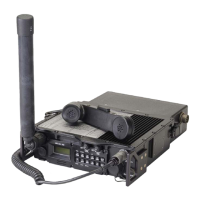General Dynamics C4 Systems URC-200 (V2)
66
4.7.1.8 Required System Equipment
Table 15 identifies minimum required equipment for a self-contained LOS communications device
operating in the LVHF band.
Table 15 - LVHF Band Required Equipment
Quantity Required Part Number Nomenclature
1 01-P36744M003 URC-200 (V2) Transceiver
1 01-P37200N001 30 to 90 MHz URC-200 (V2) Module
Assembly.
EBN -30 Option
1 85-P35988M001 Antenna VHF/UHF
1 10454 Antenna LVHF
1 01-P04535L001 Handset, H-189/GR
1 01-P36751M001 Battery Box
4.7.1.9 Sighting in LVHF Band
Although ionospheric scatter propagation is possible in the 30 to 90 MHz range, the results can be
unpredictable and sporadic. When using the URC-200 (V2) in the 30 to 90 MHz frequency band
(LVHF) it is recommended that the same line-of-sight (LOS) sighting considerations be applied as
when operating in the VHF or UHF frequency bands.
4.7.1.10 Antenna Installation
Connect the LVHF antenna to the type “N” connector on the front panel (Figure 15). Route the
gooseneck portion of the antenna base so the antenna is oriented vertically. Satisfactory
performance can be achieved with the LVHF antenna and the VHF/UHF antenna mounted on the
URC-200 (V2) at the same time. However, the unused antenna should be removed for optimum
antenna performance.
4.7.1.11 Selecting LVHF Frequencies
Press the [FREQ] key (keypad [1]) to select the frequency entry mode. To select a frequency in the
LVHF band, press zero (0) before entering the desired frequency. For example, to enter 35.6 MHz,
press [0] [3] [5] [6] [0] [0].
4.7.1.12 Squelch
The 30 to 90 MHz band employs a 150 Hz Tone Squelch. To activate the Tone Squelch, press the
[TONE] key (keypad [2]). A lower case “t” appears at the 100 MHz position on the display when
the Tone Squelch is active, or turned ON. When using the 150 Hz Tone Squelch, the Squelch
Control will not affect the tone squelch threshold. It should be noted that the only signals that will
break the receiver’s squelch, when the Tone Squelch is ON, are those that are on-channel and are
being modulated with a 150 Hz tone that has a sufficient deviation level to break the receiver’s tone
squelch threshold.

